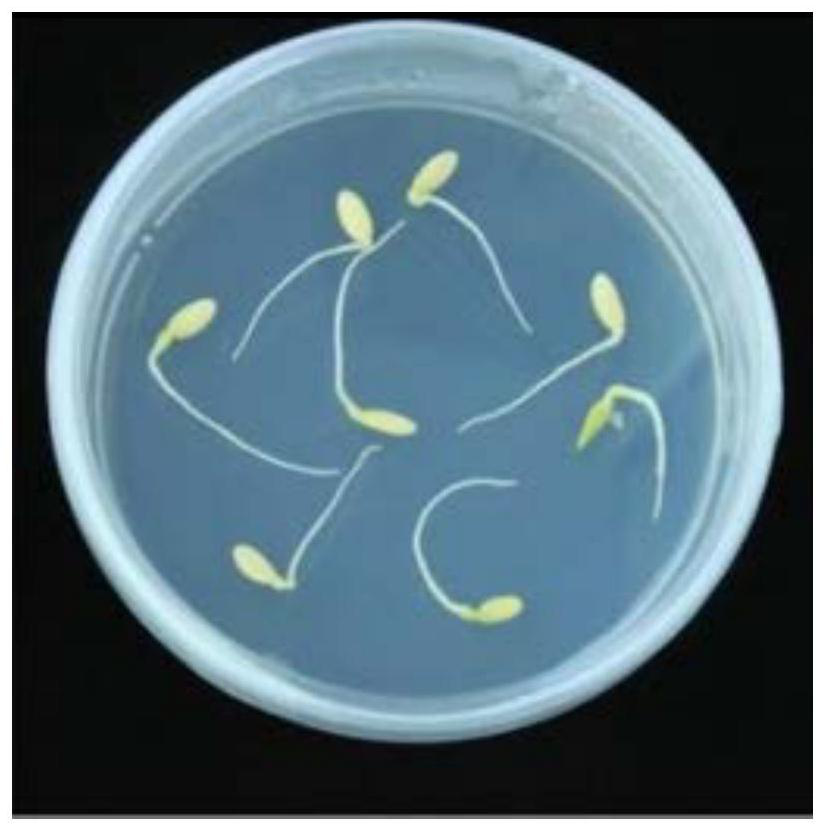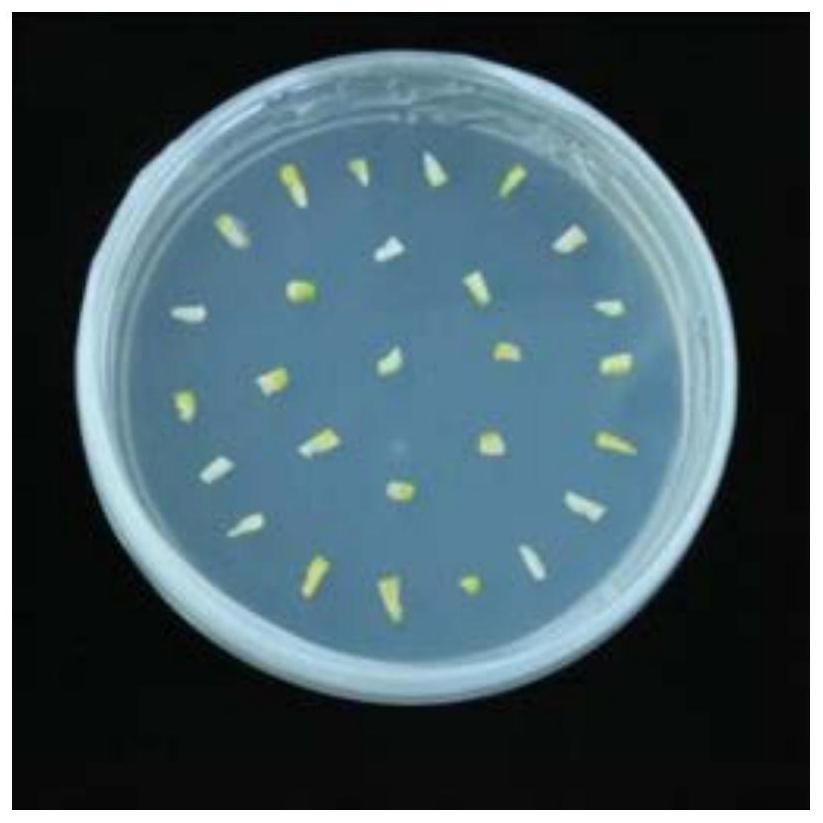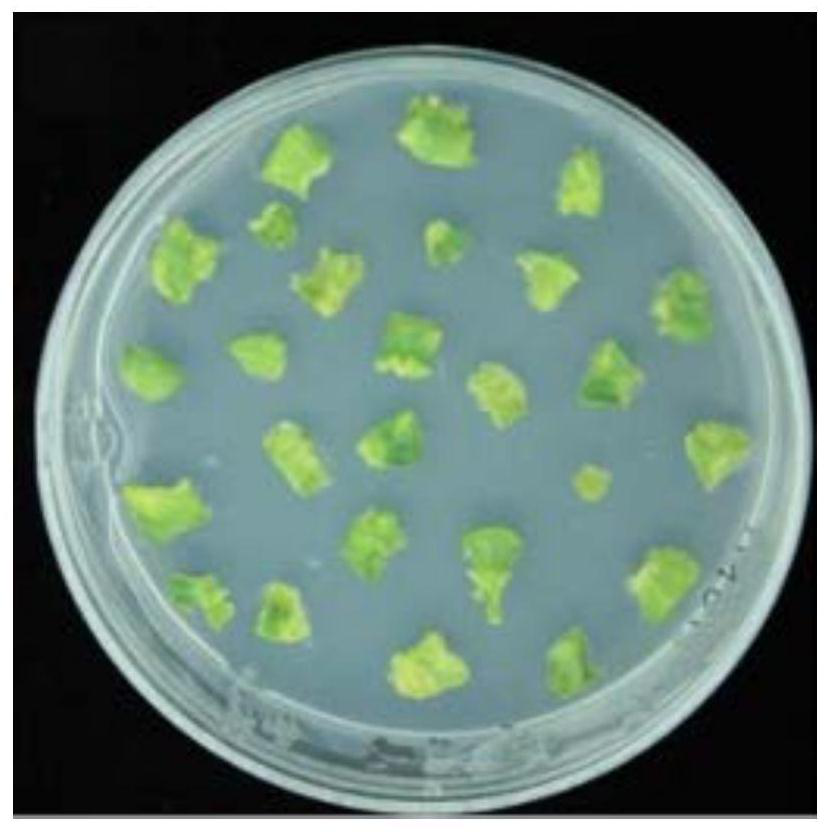Efficient agrobacterium tumefaciens-mediated melon genetic transformation method
A genetic transformation method, Agrobacterium-mediated technology, is applied in the field of highly efficient Agrobacterium-mediated genetic transformation of melons, which can solve the problems of no melons, and the low ratio of regenerated shoots with clustered buds to take root to form complete plants, so as to increase the number and reduce the number of yellow melons. The effect of conversion rate
- Summary
- Abstract
- Description
- Claims
- Application Information
AI Technical Summary
Problems solved by technology
Method used
Image
Examples
preparation example Construction
[0052] The preparation process of bud extension medium MeM4 is (for example, the amount of 100 mL): take finished powder 0.44g, sucrose 3g, agar powder 0.9g, and the composition of plant growth regulator 0.05~0.1mg·L -1 6-BA+0.5~1.0mg·L -1 GA3, make up to 100 mL with double distilled water, adjust the pH to 5.80-5.85, and after sterilization, when the temperature is lowered to 55 °C, add 100 μl of 200 mg / ml inhibitor, 100 μl to 125 μl of 20 to 25 mM silver thiosulfate.
[0053] Apply different types and concentrations of screening agents such as kanamycin (Kan15-25mg / L), hygromycin (Hpt 5-10mg / L), glufosinate-ammonium (Basta 8-10mg / L) according to the selection marker on the genetic transformation vector ), etc., mix evenly and dispense into sterile petri dishes for later use.
[0054] Wherein the method for preparing 20mM silver thiosulfate mother liquor is divided into three steps:
[0055] (1) 100mM sodium thiosulfate preparation method: 158mg sodium thiosulfate is disso...
Embodiment 1
[0074] 1. Regeneration efficiency of different types of melon germplasm on MeM3 medium
[0075] Seed selection: thick-skinned melon types, Dumi No. 5, Jade Mushroom, Jiucuimei, Snow Honey, Lemon Honey, Thin-skinned Melon Melon, Green Honey, and Wu Nong Qingyu;
[0076] S1, inoculate on seed germination medium MeM1 after seed selection and sterilization and cultivate in dark, for subsequent use;
[0077] Specifically: selected plump melon seeds were soaked in water at 50°C for 15 minutes, then soaked in tap water for 1 hour, and then rinsed the seeds twice with tap water. Gently cut the side surface of the seeds with a knife, and place the peeled seeds in a sterilized conical flask.
[0078] Seed disinfection steps: soak in 70% ethanol for 30s, and shake gently, then soak the seeds in 0.1% mercuric chloride for 8 minutes, shake gently during the period, rinse the seeds with sterile water 3 times, 5 minutes each time, end Then use sterile filter paper to absorb water for later...
Embodiment 2
[0094] The aforementioned S1-S3 steps in this example are the same as those in Example 1, and 0.5 mg·L was selected in MeM3 medium -1 6-BA+0.5mg·L -1 Zeatin+0.08mg·L -1 IAA as a plant growth regulator in induction regeneration medium;
[0095] S4, the bud cluster regenerated on the step S3 medium is cut off and placed in the bud extension medium MeM4 and continues to screen and cultivate, until the bud is extended to 2cm and then transferred to the rooting medium (such as Figure 1D );
[0096] 1. The bud elongation rate of different types of melon germplasm on MeM4 medium (the bud length is 1cm-1.5cm is the statistical value), as shown in the following table 3-6:
[0097] Among them, the preparation process of bud extension medium MeM4 is (for example, the amount of 100mL): take finished product powder 0.44g, sucrose 3g, agar powder 0.9g, and the composition of plant growth regulator 0.05~0.1mg·L -1 6-BA+0.5~1.0mg·L - 1 GA3, make up to 100 mL with double distilled wate...
PUM
 Login to View More
Login to View More Abstract
Description
Claims
Application Information
 Login to View More
Login to View More - R&D
- Intellectual Property
- Life Sciences
- Materials
- Tech Scout
- Unparalleled Data Quality
- Higher Quality Content
- 60% Fewer Hallucinations
Browse by: Latest US Patents, China's latest patents, Technical Efficacy Thesaurus, Application Domain, Technology Topic, Popular Technical Reports.
© 2025 PatSnap. All rights reserved.Legal|Privacy policy|Modern Slavery Act Transparency Statement|Sitemap|About US| Contact US: help@patsnap.com



